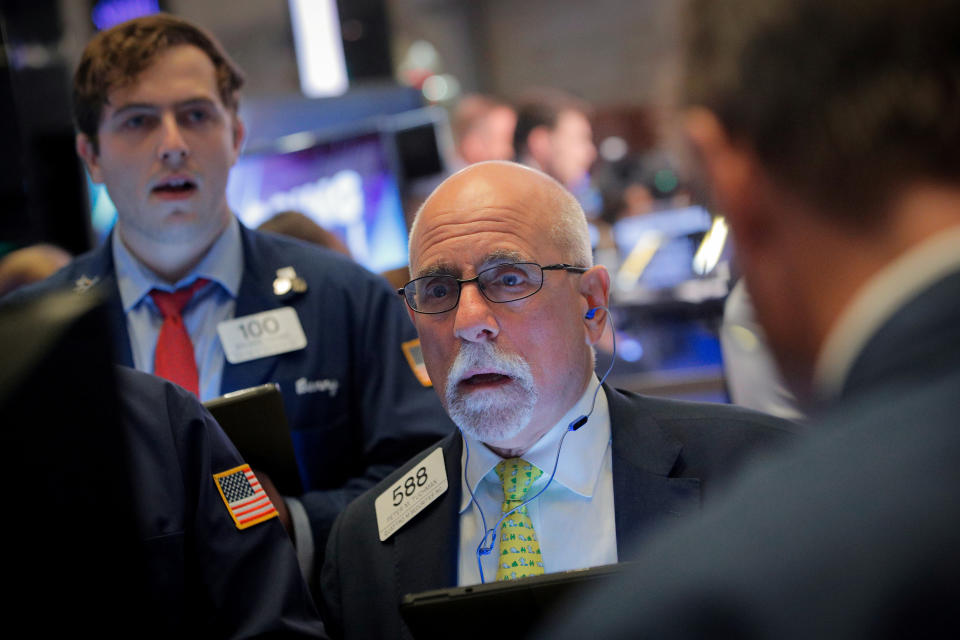Stock market news: August 5, 2019
U.S. stocks posted their largest one-day losses of 2019 on Monday after China suggested it was weaponizing its currency, in the latest salvo of the U.S.-China trade war.
Here were the main moves in the market, as of market close:
S&P 500 (^GSPC): -2.98%, or 87.31 points
Dow (^DJI): -2.9%, or 767.27 points
Nasdaq (^IXIC): -3.47%, or 278.03 points
10-year Treasury yield (^TNX): -12.4 bps to 1.731%
U.S. dollar index (DX-Y.NYB): -0.64% to 97.45
U.S. dollar to onshore Chinese yuan rate (USD/CNY=X): +1.54% to 7.0457
Investors fled risk assets and flocked to havens including gold, Treasurys and the Japanese yen. For U.S. equities, selling accelerated throughout the day, before stocks pared some losses in the last hour of trading. The Dow shed as many as 961.63 points at the lows of the day, with tech stocks including Apple (AAPL) leading declines. The S&P 500, Dow and Nasdaq have each so far posted their worst starts to August since 2011.
This came after China let the yuan weaken past seven per U.S. dollar on Monday for the first time in more than 10 years. The move stoked fears that China was intentionally undervaluing its currency to make its exports more competitive in global markets – which could contribute to an even wider U.S. trade deficit.
Officials for the People’s Bank of China have previously argued that the 7 yuan per dollar level was arbitrary, said Julian Evans-Pritchard, senior China economist for Capital Economics. However, the PBOC had “previously intervened to prevent the currency from breaching this threshold, no doubt mindful of the headlines it would create,” he added.
The move “has more symbolic than economic significance,” said Societe Generale’s macroeconomic strategist Kit Juckes, but sent shockwaves through global risk assets Monday morning as investors considered China’s apparent retaliation in an escalating trade war with the U.S.
In a Twitter post Monday morning, President Donald Trump assailed China for letting the yuan slide, calling the move a “major violation which will greatly weaken China over time!”
China dropped the price of their currency to an almost a historic low. It’s called “currency manipulation.” Are you listening Federal Reserve? This is a major violation which will greatly weaken China over time!
— Donald J. Trump (@realDonaldTrump) August 5, 2019
Trump has repeatedly called out China for allegedly undervaluing its currency, and said during his presidential campaign that the country should be called a currency manipulator. Earlier this year, the Trump administration decided not to label China – or any other country – a currency manipulator, but placed the country on a watch list for potentially unfair currency practices.
In a statement, the People’s Bank of China denied intentionally weakening the yuan as a retaliatory move against the U.S., saying it would “not engage in competitive devaluation” or “use the exchange rate as a tool to deal with external disturbances such as trade disputes,” according to a translation.
The yuan is second to the euro by weight in the Federal Reserve’s trade-weighted dollar basket, and is the largest component of the European Central Bank’s (ECB) trade-weighted euro basket.
“For the euro, it’s another weight to bear as weaker trade hurts an economy without enough growth to cope with a stronger (trade-weighted) currency,” Juckes said in a note. “For the U.S. President of course, with his concerns about the dollar being too strong, it is going to be a source of significant irritation. The debate about U.S. FX intervention is going to heat up significantly.”

The Chinese government has also asked state-owned firms to stop purchasing more U.S. agricultural imports, Bloomberg reported Monday, in another move to hit back at the Trump administration for its latest tariff imposition announcement last week. Trump’s desire for China to step up purchases of American farm goods has been one of the sticking points in the path to a trade agreement.
Beijing’s latest trade-related measures come after President Donald Trump last week unexpectedly announced he would be slapping a 10% tariff on $300 billion worth of Chinese imports starting September 1, adding to $250 billion worth of Chinese goods already subject to a 25% rate. China’s Commerce Ministry said shortly thereafter that it would “take necessary countermeasures” to defend itself. Though the country did not “want a trade war,” it was “not afraid of fighting one,” the Commerce Ministry said.
Delegations from the U.S. and China re-started in-person trade talks for the first time since May last week. The two sides are set to meet again in September.
Separately, Monday morning, the Institute of Supply Management (ISM) released a reading on the U.S. non-manufacturing sector that came in at the weakest level since August 2016. This came after a print last week from ISM on the U.S. manufacturing sector showed that activity in these industries also fell to a three-year low. The U.S. services sector comprises a much larger portion of the domestic economy than the manufacturing sector.
The ISM’s headline non-manufacturing sector index registered at 53.7 for July, weakening from June’s 55.1 level and missing consensus economist expectations for a reading of 55.5.
“Respondents indicated ongoing concerns related to tariffs and employment resources,” Anthony Nieves, chair of the ISM, said in a statement. “Comments remained mixed about business conditions and the overall economy.”
—
Emily McCormick is a reporter for Yahoo Finance. Follow her on Twitter: @emily_mcck
Read more from Emily:
Economy adds 164,000 jobs in July, unemployment rate sits at 3.7%
Netflix’s 2Q global paid subscriber additions miss expectations
Tech companies like Lyft want your money – not ‘your opinion’
Follow Yahoo Finance on Twitter, Facebook, Instagram, Flipboard, LinkedIn, and reddit.
Read the latest financial and business news from Yahoo Finance

 Yahoo Finance
Yahoo Finance 